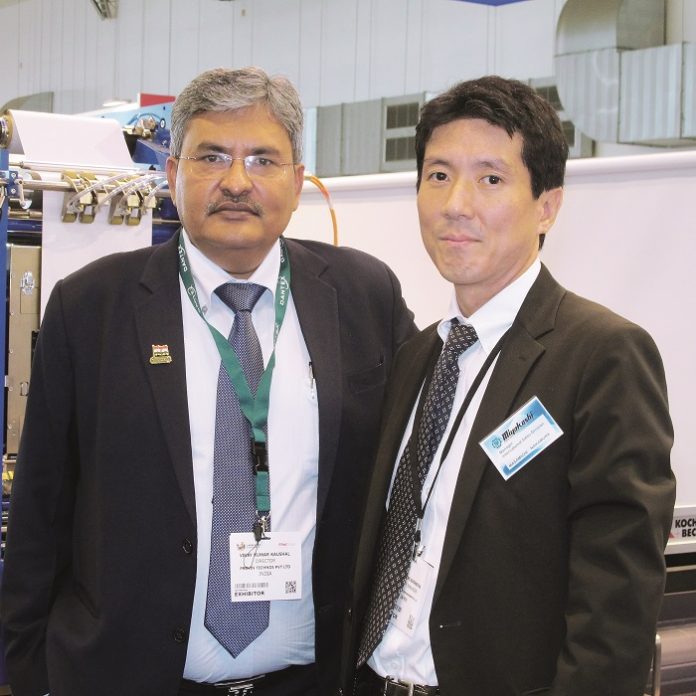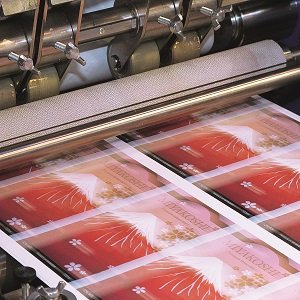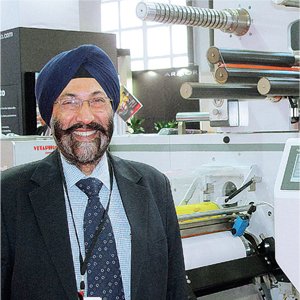
“There are two common assumptions about the narrow web label sector—that the conventional flexo is a mature technology with only incremental advances and that digital is advancing rapidly. But at this year’s Labelexpo Europe both the assumptions were turned on their head with several new flexo presses, inks, sleeves and plates matched by an obvious slow-down in the onward march of digital progress.” ~ Nessan Cleary, freelance industry journalist. ww.nessancleary.co.uk
 Cleary points to two obvious trends at the show, the first being greater automation to speed up changeovers to make a flexo press more efficient and the second toward wider flexo presses aimed at the flexible and carton packaging market. I believe there is a third trend, which was perhaps not as obvious, but nevertheless more pronounced than at earlier shows—one that points to more hybrid presses using not only flexo and digital but also offset for filmic labels and flexible packaging.
Cleary points to two obvious trends at the show, the first being greater automation to speed up changeovers to make a flexo press more efficient and the second toward wider flexo presses aimed at the flexible and carton packaging market. I believe there is a third trend, which was perhaps not as obvious, but nevertheless more pronounced than at earlier shows—one that points to more hybrid presses using not only flexo and digital but also offset for filmic labels and flexible packaging.
The idea of offset for printing on flexibles has been around for more than four drupas if one recalls the Drent VSOP at drupa 2004 and the Goss International Vpak press shown at drupa 2008 and the Omet Varyflex shown at drupa 2016, which is a hybrid press capable of running at 400 meters a minute and which was actually a press built for Huhtamaki.
Offset printing for labels is often used in India too on Iwasaki cold offset or waterless offset presses as well as the Rotatek Brava and Omet Varyflex presses by label printers such as Ajanta, Wintek, SelJagat, Update Prints, and Manohar Packaging. In addition, there are several Chinese-made web-fed intermittent offset presses also used by Indian label converters.
The idea is generally to chill the plate cylinders so that minimal dampening is required or by the use of waterless offset plates such as those supplied by Toray. Thus, although the idea is not really new, web-fed offset printing may catch on in the next few years for wider web label presses and particularly for printing paper and film labels including shrink wrap and in-mold labels together with flexible packaging such as pouches.
At Labelexpo in Brussels, offset label presses included the Omet X6 Offset press—one of the three presses that it displayed during the show. While the other two Omet presses at the show were flexo presses, all three were run live in demonstrations that emphasized the automation and connectivity of the presses in line with the Industry 4.0 concept. Workflow efficiencies and automation was something that most manufacturers were pushing and it seems that the larger Indian label printers are warming up to automation concepts.

Designed for the production of flexible labels and packaging, the Contitech-DG Thallo web offset shown at Labelexpo is produced under a strategic partnership between Contiweb and DG Press Services since drupa 2016, and it is claimed that three presses have been sold in the past year. The Contiweb Thallo system integrates web offset with flexo, gravure or digital units into hybrid configurations for a wide range of printing applications.
The Miyakoshi intermittent UV waterless web-offset label press shown at Brussels drew fairly large interest from visitors, including the Indian at the show because of the news that Pragati Pack has purchased an intermittent Miyakoshi 420 mm wide press with seven offset units and two flexo units and flatbed diecutting as well as foiling unit for its packaging and label plant in Hyderabad. A couple of months ago, Pragati showed us some very high value labels that it plans to produce on the press that include embossed and foil effects.
The Miyakoshi MLP13H 330 mm UV offset waterless press at Labelexpo was was shown running at 120 meters a minute in intermittent or semi-rotary mode, which is an extremely competitive speed close to that of many narrow web flexo label presses. The press is available as a combination press to run in both semi-rotary and full rotary modes and can also be purchased as full rotary press running at speeds of 350 meters a minute.
Label press signings by Indian and Sri Lankan converters

Several press order signings sold before and around the show were being talked about in Brussels. An informal back of the envelope survey suggests that about 18 or 19 narrow web flexo label presses were signed for by Indian converters either at the show or in sufficient proximity to be claimed as show sales (although some of the claims are really quite a bit earlier than the show). While most of the actual orders were negotiated beforehand and preplanned for signing and announcements at the show, it is not clear that the actual installations in the financial year till 31 March 2018 will actually wind up much higher than in the previous financial year. At this point we are estimating anywhere between 25 and 30 installations of these presses till March.
Among the announcements are those of Gallus selling its first Labelmaster press to an Indian customer: ITW-Signode Wintek. Not much has been revealed except that the press is a 430 mm wide Labelmaster Advanced model demonstrated in Brussels in end-September and that it will be installed at Wintek’s Bengaluru plant. Other announcements include the sale of multiple numbers of Mark Andy Performance Series P5, including a sale to a Sri Lankan customer, Lombardy Synchroline and Nilpeter presses. Omet too announced the sale of an IFlex 370 press as a Labelexpo signing.










